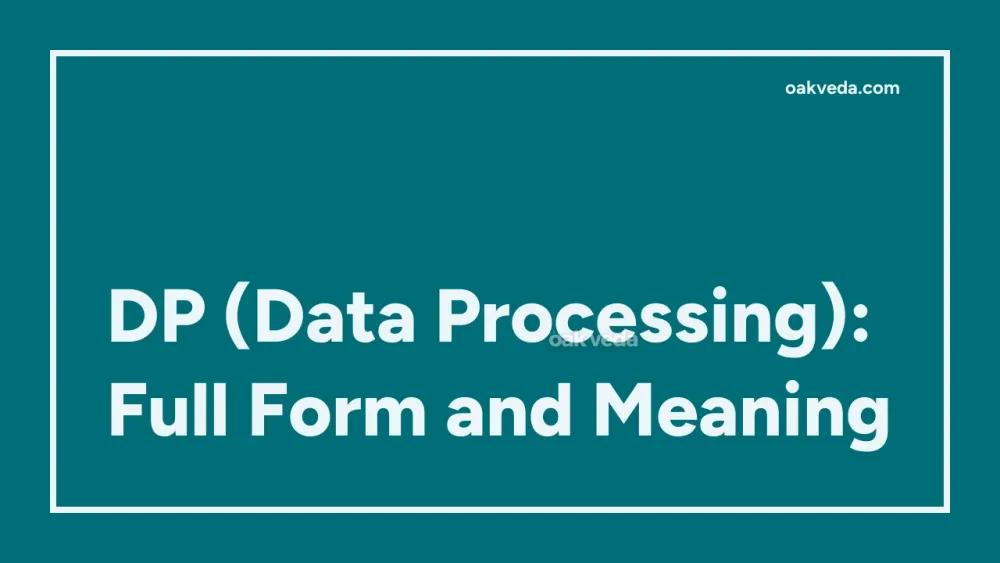
What is the Full Form of DP?
The full form of DP is Data Processing. This term is widely used in the field of computer science and information technology to describe the manipulation and transformation of raw data into meaningful information.
What is Data Processing?
Data Processing refers to the systematic manipulation of data by a computer or other automated means. It involves collecting, organizing, storing, analyzing, and interpreting large volumes of data to extract useful information. This process is crucial in today's data-driven world, where organizations rely heavily on information for decision-making and strategic planning.
Origin and Development of Data Processing
The concept of data processing has evolved significantly since the early days of computing. Initially, it was primarily associated with simple mathematical calculations and basic data manipulation. However, with the advent of more powerful computers and sophisticated software, data processing has grown into a complex field encompassing a wide range of techniques and methodologies.
In the 1950s and 1960s, data processing was largely limited to punch card systems and early mainframe computers. As technology advanced, so did the capabilities of data processing systems. The introduction of personal computers in the 1980s and the internet in the 1990s revolutionized the field, making data processing more accessible and efficient.
How does Data Processing work?
Data Processing typically involves several stages:
- Data Collection: Gathering raw data from various sources
- Data Preparation: Cleaning and organizing the collected data
- Data Input: Entering the prepared data into the processing system
- Processing: Applying algorithms and calculations to the data
- Data Output: Generating results in a usable format
- Data Storage: Storing the processed data for future use
These stages may vary depending on the specific application and requirements of the data processing task.
Types of Data Processing
Data Processing can be categorized into several types:
- Batch Processing: Processing large volumes of data at scheduled intervals
- Real-time Processing: Processing data immediately as it is received
- Online Processing: Processing data through an internet connection
- Multiprocessing: Using multiple processors simultaneously for faster data processing
- Time-sharing: Allowing multiple users to access the processing system concurrently
Functions of Data Processing
The primary functions of Data Processing include:
- Validation: Ensuring the accuracy and integrity of input data
- Sorting: Arranging data in a specific order (e.g., alphabetical, numerical)
- Summarization: Condensing large datasets into concise, meaningful information
- Aggregation: Combining multiple data points into a single result
- Analysis: Applying statistical and mathematical techniques to extract insights
- Classification: Categorizing data into predefined groups or classes
- Reporting: Presenting processed data in a comprehensible format
Applications of Data Processing
Data Processing finds applications in numerous fields:
- Business Intelligence: Analyzing market trends and consumer behavior
- Scientific Research: Processing experimental data and simulations
- Healthcare: Managing patient records and analyzing medical data
- Finance: Processing transactions and performing risk analysis
- Education: Managing student information and analyzing academic performance
- Government: Processing census data and managing public records
- Manufacturing: Optimizing production processes and quality control
Features of Data Processing
Key features of modern Data Processing systems include:
- Automation: Minimizing manual intervention in data handling
- Scalability: Ability to handle increasing volumes of data
- Accuracy: Ensuring precise and error-free results
- Speed: Rapid processing of large datasets
- Flexibility: Adapting to various data formats and processing requirements
- Security: Protecting sensitive data from unauthorized access
Benefits of Data Processing
Effective Data Processing offers numerous benefits:
- Improved decision-making through data-driven insights
- Enhanced operational efficiency and productivity
- Better resource allocation and cost management
- Increased competitiveness in the market
- Improved customer satisfaction through personalized services
- Enhanced research capabilities in scientific and academic fields
Limitations or Challenges of Data Processing
Despite its advantages, Data Processing faces several challenges:
- Data Quality: Ensuring the accuracy and reliability of input data
- Privacy Concerns: Maintaining data confidentiality and compliance with regulations
- Complexity: Managing increasingly complex data structures and processing requirements
- Cost: Investing in advanced hardware and software for efficient processing
- Skill Gap: Finding skilled professionals to manage sophisticated data processing systems
Future Developments in Data Processing Technology
The field of Data Processing continues to evolve rapidly. Some emerging trends include:
- Artificial Intelligence and Machine Learning: Enhancing data processing capabilities through intelligent algorithms
- Edge Computing: Processing data closer to its source for faster results
- Quantum Computing: Exploring new frontiers in processing speed and capacity
- Blockchain: Enhancing data security and transparency in processing
- Natural Language Processing: Improving the ability to process and understand human language
FAQs on DP Full Form
-
What is another full form of DP? Another common full form of DP is Display Picture, often used in the context of social media profile images.
-
How is Data Processing different from Data Mining? While Data Processing focuses on transforming raw data into usable information, Data Mining specifically aims to discover patterns and relationships within large datasets.
-
Is Data Processing only relevant for large organizations? No, Data Processing is relevant for organizations of all sizes, as well as individuals who need to manage and analyze data effectively.
-
What skills are required for a career in Data Processing? Key skills include programming, database management, statistical analysis, and a strong understanding of data structures and algorithms.
-
How does Data Processing contribute to Big Data analytics? Data Processing forms the foundation of Big Data analytics by preparing and transforming vast amounts of data for advanced analysis and insights.
You may be interested in:

